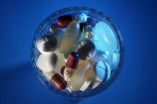(Press-News.org) Jena (Germany) It is something like the police force of our body: the immune system. It disables intruding pathogens, it dismantles injured tissue and boosts wound healing. In this form of 'self-defense' inflammatory reactions play a decisive role. But sometimes the body's defense mechanism gets out of control and cells or tissues are affected: "Then excessive reactions can occur and illnesses along with them," Prof. Dr. Oliver Werz of the Friedrich Schiller University Jena says. He gives asthma, rheumatism, arteriosclerosis and cancer as examples: "For many of these diseases there are only few effective therapies without severe side effects."
But the team of researchers working together with the Jena pharmacist has now developed three active agents which may be able to improve the healing of inflammatory illnesses better in future. The scientists present the potential therapeutic agents in renowned scientific journals. The agents are able to suppress a key enzyme in the body's own cascade of inflammation.
"The enzyme called 5-LOX plays a pivotal role in the synthesis of so-called leukotrienes, which are part of numerous immunological and inflammatory processes," Prof. Werz explains. Hence, the effort to prevent the synthesis of leukotrienes has been the focus of international research for inflammatory therapy for a long time. "Thousands of publications on the subject have emerged in the last 30 years," says Werz. But apart from one exception none of these efforts have made it to the stage of an approved medication. Either the efficacy of the substances was poor or they were accompanied by unwanted side effects.
As a reason behind this, the Jena pharmacist sees the insufficient understanding of cellular regulation of the leukotriene biosynthesis and the lack of knowledge of the molecular mechanisms of agent and target molecule. "Instead of testing a number of substances to see if one of them might show any activity, we took a close look at 5-LOX and tried to find where exactly this enzyme is vulnerable and what the agents, which can interact with our target molecule, should look like," Werz describes the basis-orientated approach. In this way the scientists of the Jena University together with partners from Austria, Italy, Turkey and Greece, were able to identify three possible agents. So for instance, a so-called benzoquinone proved to be an effective inhibitor of the 5-LOX. This is a substance which is derived from the natural product embelin from the "False Black Pepper"-plant (Embelia ribes). The pharmacists were able to show that this substance fits exactly into the active center of the enzyme and thus blocks its function. "This specifically only happens with 5-LOX," Werz says and stresses that benzoquinone may practically show no side effects.
A related substance of the red-violet natural dye indirubin, called 6-BIO, proved to be similarly promising. For this substance, the Jena researchers were able to clarify the mechanism of action as well: the 6-BIO inhibits the enzyme 5-LOX by blocking receptor sites for other molecules which are necessary for it to work properly. "In addition, 6-BIO also intervenes with the synthesis of additional inflammatory factors – the cytokines implying additional synergistic effects." This is why 6-BIO could for instance be of interest for the therapy of Alzheimer's disease, in which cytokines are also playing a role.
The third possible active agent from the Jena University's laboratory does not inhibit the 5-LOX itself, but it deactivates a helper-protein, which the enzyme needs for its effectiveness within the cell. The researchers identified this active agent, a benzimidazole with the short term BRP-7, by a virtual screening in a library consisting of nearly three million substances. "From our point of view all three of the drug candidates are very well suited to a further development as medications," Prof. Werz summarizes. However, for this, the support of the pharmceutical industry is needed.
INFORMATION:
Original Publications:
Schaible AM et al. Elucidation of the molecular mechanism and the efficacy in vivo of a novel 1,4-benzoquinone that inhibits 5-lipoxygenase. British Journal of Pharmacology 2014 (DOI:10.1111/bph.12592)
Pergola C et al. Indirubin core structure of glycogen synthase kinase-3 inhibitors as novel chemotype for intervention with 5-lipoxygenase. Journal of Medical Chemistry 2014 (DOI:10.1021/jm401740w)
Pergola C et al. The novel benzimidazole derivative BRP-7 inhibits leukotriene biosynthesis in vitro and in vivo by targeting 5-lipoxygenase-activating protein (FLAP). British Journal of Pharmacology 2014 (DOI:10.1111/bph.12625)
Contact:
Prof. Dr. Oliver Werz
Institute of Pharmacy
Friedrich Schiller University Jena
Philosophenweg 14, 07743 Jena
Germany
Phone: ++49 3641 / 949801
Email: oliver.werz@uni-jena.de
Attack is not always the best defense
Pharmacists at Jena University develop 3 new drug candidates against inflammation
2014-05-27
ELSE PRESS RELEASES FROM THIS DATE:
The secret cargo of mosquitoes
2014-05-27
The parasite Dirofilaria repens is a roundworm that primarily attacks the subcutaneous tissue of dogs and causes lumps in the skin, swelling, and itching. Dogs, cats, foxes, wolves and martens can be infected in addition to dogs. "In humans, 16 cases of human dirofilariosis have been recorded since the year 2000, but the dark figure is definitely higher", says the lead author Katja Silbermayr. Humans, however, are so-called dead end hosts; the parasite does not reproduce in humans and therefore poses no major risk.
Silbermayr is a veterinarian and performs research on ...
Seeing e-cigarette use encourages young adult tobacco users to light up
2014-05-27
VIDEO:
"Whether participants were exposed to someone smoking a combustible or an e-cigarette, the urge to smoke a combustible cigarette was just as high in either condition, " King said. "If the...
Click here for more information.
Seeing people use electronic cigarettes (e-cigarettes) increases the urge to smoke among regular combustible cigarettes users, according to a new study of young adult smokers. This elevated desire is as strong as when observing someone ...
Stanford researchers discover immune system's rules of engagement
2014-05-27
A study led by researchers at Stanford's School of Medicine reveals how T cells, the immune system's foot soldiers, respond to an enormous number of potential health threats.
X-ray studies at the Department of Energy's SLAC National Accelerator Laboratory, combined with Stanford biological studies and computational analysis, revealed remarkable similarities in the structure of binding sites, which allow a given T cell to recognize many different invaders that provoke an immune response.
The research demonstrates a faster, more reliable way to identify large numbers ...
Climate change accelerates hybridization between native and invasive species of trout
2014-05-27
BOZEMAN, Mont. – Scientists have discovered that the rapid spread of hybridization between a native species and an invasive species of trout in the wild is strongly linked to changes in climate.
In the study, stream temperature warming over the past several decades and decreases in spring flow over the same time period contributed to the spread of hybridization between native westslope cutthroat trout and introduced rainbow trout – the world's most widely introduced invasive fish species –across the Flathead River system in Montana and British Columbia, Canada.
Experts ...
New perspectives to the design of molecular cages
2014-05-27
Researchers from the University of Jyväskylä report a new method of building molecular cages. The method involves the exploitation of intermolecular steric effects to control the outcome of a self-assembly reaction.
Molecular cages are composed of organic molecules (ligands) which are bound to metal ions during a self-assembly process. Depending on the prevailing conditions, self-assembly processes urge to maximize the symmetry of the system and thus occupy every required metal binding site. The research group led by docent Manu Lahtinen (University of Jyväskylä, Department ...
Molecules do the triple twist
2014-05-27
An international research team led by Academy Professor Kari Rissanen of the University of Jyväskylä (Finland) and Professor Rainer Herges of the University of Kiel (Germany) has managed to make a triple-Möbius annulene, the most twisted fully conjugated molecule to date, as reported in Nature Chemistry (DOI:10.1038/nchem.1955, published online 25 May 2014).
An everyday analogue of a single twisted Möbius molecule is a Möbius strip. It can be made easily by twisting one end of a paper strip by 180 degrees and then joining the two ends. A triple twisted Möbius molecule ...
Insights into genetics of cleft lip
2014-05-27
Scientists at the European Molecular Biology Laboratory (EMBL) in Heidelberg, have identified how a specific stretch of DNA controls far-off genes to influence the formation of the face. The study, published today in Nature Genetics, helps understand the genetic causes of cleft lip and cleft palate, which are among the most common congenital malformations in humans.
"This genomic region ultimately controls genes which determine how to build a face and genes which produce the basic materials needed to execute this plan", says François Spitz from EMBL, who led the work. ...
Clinical trial reaffirms diet beverages play positive role in weight loss
2014-05-27
May 27, 2014 – A groundbreaking new study published today in Obesity, the journal of The Obesity Society, confirms definitively that drinking diet beverages helps people lose weight.
"This study clearly demonstrates that diet beverages can in fact help people lose weight, directly countering myths in recent years that suggest the opposite effect – weight gain," said James O. Hill, Ph.D., executive director of the University of Colorado Anschutz Health and Wellness Center and a co-author of the study. "In fact, those who drank diet beverages lost more weight and reported ...
Heavily decorated classrooms disrupt attention and learning in young children
2014-05-27
VIDEO:
Maps, number lines, shapes, artwork and other materials tend to cover elementary classroom walls. However, new research from Carnegie Mellon University shows that too much of a good thing may...
Click here for more information.
PITTSBURGH—Maps, number lines, shapes, artwork and other materials tend to cover elementary classroom walls. However, new research from Carnegie Mellon University shows that too much of a good thing may end up disrupting attention and learning in ...
Migrating stem cells possible new focus for stroke treatment
2014-05-27
Two years ago, a new type of stem cell was discovered in the brain that has the capacity to form new cells. The same research group at Lund University in Sweden has now revealed that these stem cells, which are located in the outer blood vessel wall, appear to be involved in the brain reaction following a stroke.
The findings show that the cells, known as pericytes, drop out from the blood vessel, proliferate and migrate to the damaged brain area where they are converted into microglia cells, the brain's inflammatory cells.
Pericytes are known to contribute to tissue ...
LAST 30 PRESS RELEASES:
Groundbreaking mapping: how many ghost particles all the Milky Way’s stars send towards Earth
JBNU researchers propose hierarchical porous copper nanosheet-based triboelectric nanogenerators
A high-protein diet can defeat cholera infection
A more accurate way of calculating the value of a healthy year of life
What causes some people’s gut microbes to produce high alcohol levels?
Global study reveals widespread burning of plastic for heating and cooking
MIT study shows pills that communicate from the stomach could improve medication adherence
Searching for the centromere: diversity in pathways key for cell division
Behind nature’s blueprints
Researchers search for why some people’s gut microbes produce high alcohol levels
Researchers find promising new way to boost the immune response to cancer
Coffee as a staining agent substitute in electron microscopy
Revealing the diversity of olfactory receptors in hagfish and its implications for early vertebrate evolution
Development of an ultrasonic sensor capable of cuffless, non-invasive blood pressure measurement
Longer treatment with medications for opioid use disorder is associated with greater probability of survival
Strategy over morality can help conservation campaigns reduce ivory demand, research shows
Rising temperatures reshape microbial carbon cycling during animal carcass decomposition in water
Achieving ultra-low-power explosive jumps via locust bio-hybrid muscle actuators
Plant-derived phenolic acids revive the power of tetracycline against drug-resistant bacteria
Cooperation: A costly affair in bacterial social behaviour?
Viruses in wastewater: Silent drivers of pollution removal and antibiotic resistance
Sub-iethal water disinfection may accelerate the spread of antibiotic resistance
Three in four new Australian moms struggle with body image
Post-stroke injection protects the brain in preclinical study
Cardiovascular risk score predicts multiple eye diseases
Health: estimated one in ten British adults used or interested in GLP-1 medications for weight loss
Exercise to treat depression yields similar results to therapy
Whooping cough vaccination for pregnant women strengthens babies’ immune system
Dramatic decline in new cases of orphanhood in Uganda driven by HIV treatment and prevention programs
Stopping weight loss drugs linked to weight regain and reversal of heart health markers
[Press-News.org] Attack is not always the best defensePharmacists at Jena University develop 3 new drug candidates against inflammation




